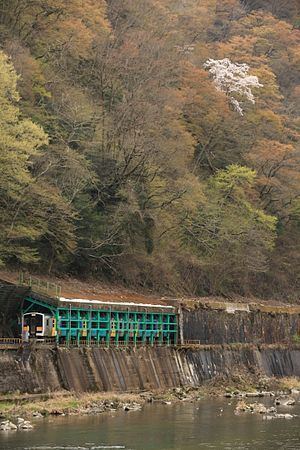Type Heavy rail Services 2 | Stations 45 Opened 1897 | |
 | ||
Line length 137.5 km (85.4 mi) (main line), 9.5 km (5.9 mi) (Hitachi-Ōta branch) Terminis | ||
Surprise on the suigun line
The Suigun Line (水郡線, Suigun-sen) is a Japanese railway line operated by East Japan Railway Company (JR East), which connects Mito Station in Ibaraki Prefecture and Asaka-Nagamori Station in Fukushima Prefecture, Japan. All trains on the line continue onto the Tōhoku Main Line to Kōriyama Station. The name of the line includes one kanji from each of the terminals, Mito (水戸) and Kōriyama (郡山).
Contents
- Surprise on the suigun line
- Jr east suigun line asaka nagamori mito f hrerstandsmitfahrt jr
- History
- Former connecting lines
- Basic data
- Services
- Stations
- Hitachi ta Branch
- Rolling stock
- Past
- References
A branch line runs from Kami-Sugaya Station to Hitachi-Ōta Station in Ibaraki Prefecture.
Jr east suigun line asaka nagamori mito f hrerstandsmitfahrt jr
History
The Ota Railway Co. opened the Mito - Kami-Sugaya - Hitachi-Ota line between 1897 and 1899, but was declared bankrupt in 1901. The 15 banks owed money formed the Mito Railway Co. to acquire the line and continue its operation. That company opened the Kami-Sugaya - Hitachi-Omiya section in 1918, resulting in the Kami-Sugaya - Hitachi-Ota line becoming the branch. The mainline was extended to Hitachi-Daigo in sections between 1922 and 1927, the year the company was nationalised.
In 1929 JGR opened the Asaka-Nagamori - Yatagawa section, extending it to Kawahighashi in 1931. The Hitachi-Daigo - Iwaki-Tanakura section was opened in stages between 1930 and 1932, and the Kawahigashi - Iwaki-Tanakura section opened in 1934, completing the line.
Freight services ceased between 1982 and 1987. CTC signalling was commissioned on the entire line in 1983.
Former connecting lines
Basic data
Services
There is generally one train every one to two hours, but between Mito and Kami-Sugaya this increases to one to two trains per hour. Only 13 trains per day run the entire length of the line; most services are from Mito to Hitachi-Ōmiya, to Hitachi-Daigo, and to Hitachi-Ōta. Between Hitachi-Daigo and Kōriyama there are few trains, with a period of 2–3 hours during midday having no services whatsoever.
There are three additional trains between Hitachi-Daigo and Kōriyama (two to Kōriyama, one to Hitachi-Daigo), a single round-trip to Kōriyama from Iwaki-Ishikawa and back, and a single evening trip from Kōriyama to Iwaki-Tanakura that proceeds to Mito the following morning.
Other seasonal trains are added on certain days throughout the year.
